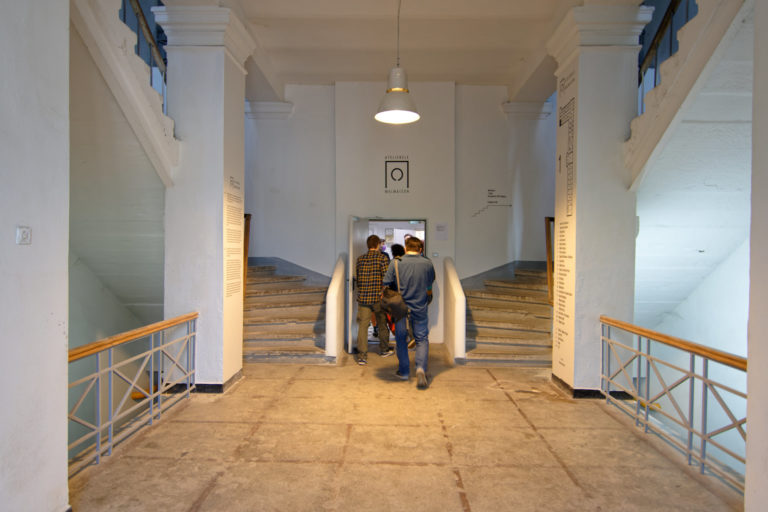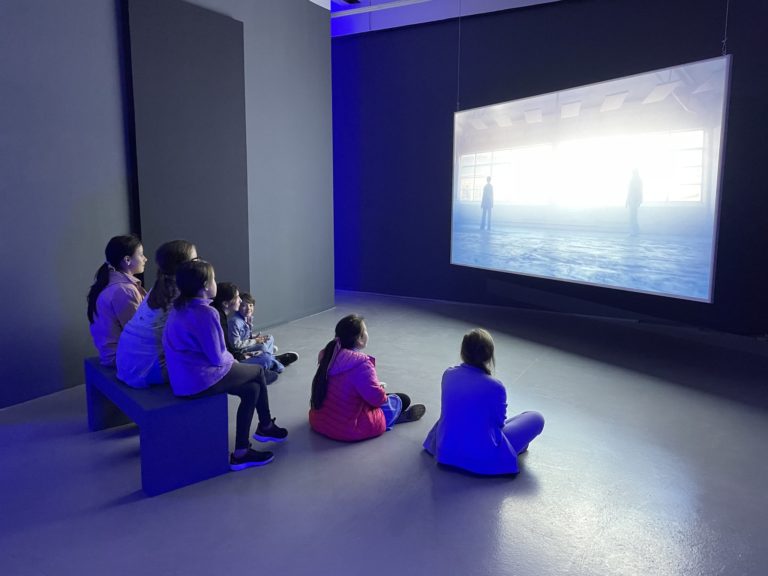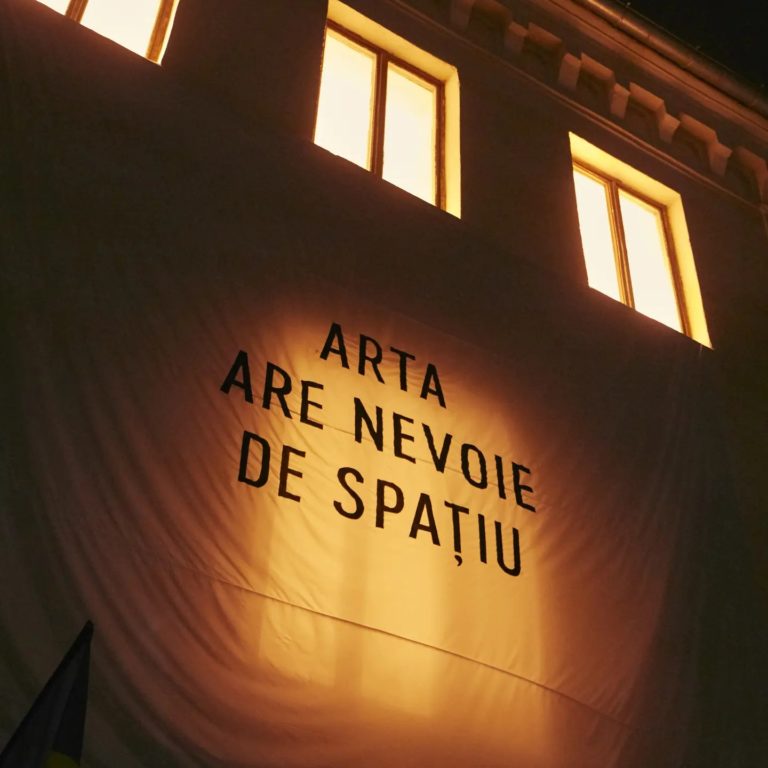Author: Danai Giannoglou
Across Europe, independent cultural players increasingly struggle to find affordable spaces to work and create, and Romania is no exception. In Bucharest, artists face significant challenges in securing studios and exhibition spaces as the city becomes increasingly commercialised, pricing out much of the independent scene. A prime example of this is Atelierele Malmaison, a collective of artists' studios housed in a historic building. Founded in 2020, Malmaison has provided vital affordable workspace for artists, but now faces eviction as rents soar. Visual artist Larisa Crunţeanu discusses the struggle to preserve this essential cultural space in a situation hostile to independent artistic spaces.

First Open Doors, 2021 – © Petre Fall
I first visited the impressive Atelierele Malmaison as part of my curatorial residency with Arc Bucharest in November 2023. The 177-year-old building has served as a military officers' school, a military court, a prison during the Antonescu regime, and a security investigation and detention centre at the beginning of the communist regime–in some ways reflecting many aspects of Romania's contemporary history. It’s only recently, in 2020, that a group of artists decided to rent part of the building and create Atelierele Malmaison, in a unique act of self-organisation with the aim of providing affordable workspace for artists and a platform for the community. However, this same community is fighting for the recognition of Malmaison’s activity and contribution by the Romanian Ministry of Culture, as they are now slowly being priced out from the space they have nurtured and cultivated in a hostile gesture towards the city’s independent scene. Visual artist Larisa Crunţeanu has been actively involved in this collective effort.
Danai Giannoglou: How is Atelierele Malmaison organised and what were the conditions that led to its creation?
Larisa Crunţeanu: Atelierele Malmaison (Malmaison Studios) is an eclectic group of artists and art spaces that came together primarily out of necessity. The majority shareholder in the building that houses Atelierele Malmaison is the Ministry of Economy, Entrepreneurship, and Tourism, through a State company. The original group of artists who set up and rented out some of the spaces in 2020 was rather small and came across the building by chance being evicted from a previous location they were sharing. I think their intention was to turn it into a cluster exclusively for artists, but since this couldn’t be regulated in any way, some galleries also appeared. In Romania in general, and in Bucharest in particular, it’s very difficult to find and rent spaces that are suitable for artists’ studios or exhibition spaces at affordable prices, so at a certain point Malmaison became a bit of a gold rush, where the first to hear about these available spaces were the first to get a foot in the door.

'Collaborative practices' workshop series for children, 2022 – © Tudor Popa
What is the role of Atelierele Malmaison in the general context of the Bucharest art scene?
LC: Atelierele Malmaison began its activities at the end of 2019-beginning of 2020 and had its first Open Doors in 2021, when more than 3,000 people came to see artists’ studios as well as galleries and project spaces open. There have been similar initiatives in Bucharest and other parts of the country in recent years, but never on the scale of Malmaison. The building itself is an attraction, with a long and complicated history spanning almost 180 years. First a military school, then a military court, and more recently, etched in the collective memory, a prison and centre for the investigation and detention of political prisoners during the communist regime.
As far as Malmaison’s role is concerned, I think the most important one was that it gave some security and also visibility to a very ignored part of Romanian culture, namely independent contemporary art and contemporary art workers. It is important to note, however, that the ignorance of both the authorities and the general public about contemporary art and the specific work and problems surrounding it is also due to the fact that we still have a functioning artists union, which offers studio and exhibition spaces, but only to its members and through very arbitrary and non-transparent procedures. So, I think this is the second important role that Malmaison has played: offering an alternative model of community to the one that already exists, that of the union, inherited from a time and a society that no longer exists.
What were the issues around which Malmaison came together as a community, at least in the beginning?
LC: Lack of affordable spaces for artists’ studios, lack of community spaces, lack of education of both the State and the general audience about the specificities of artistic work.
Has Malmaison changed the paradigm of self-organisation in the city’s cultural scene?
LC: I think it is too early to tell. Certainly, it has made the idea of collaborating and bringing together artists' studios and exhibition spaces in a single space an attractive one, as two new similar initiatives have emerged since its launch. But this does not mean that the model is sustainable on its own, without the organised commitment and support of the State, at least in part, for such endeavours. Malmaison was affordable to rent because it was an almost derelict building. It took two years to renovate, mostly at the expense of the artists involved (there were some sponsors who offered partial support with materials, but even then it was the artists who did the work). After that, in less than two years, the rent went up so much that the very same artists who found the place, did most of the work to repair it, and put it on the cultural map, found it difficult to cope. Basically, all that money and effort was used to drive up prices and rent the spaces to people who could pay more.

'Art Needs Space' banner during protests against evacuation, 2024 – © Dan Vezentan
What is happening now In Malmaison and what series of actions have you taken to reclaim it and fight for its existence and activity?
LC: The situation is actually more bizarre and complicated than the condensed and rather simplified version I attempted above.
As I said, the building is owned by a partly State-owned company with a very bureaucratic decision-making system, but also very problematic and corrupt members of the board. The first artists to leave were those who had the oldest contracts from 2020, on the first floor of the building. When their contracts expired, they saw their rent increase by almost 30%, with the possibility of another increase three months later. The second floor, where I have my studio and which became available for rent a year later, was organised under a collective contract signed for a longer period (until the beginning of 2026). When the first rent increases took place, we felt it was a matter of solidarity to react publicly, regardless of whether we were directly affected or not. It was also a threat to the whole community, because it was clear that the moment even this longer contract we currently have expires, we will be evicted. Public letters, protest works and performances, official visits, scouting for other buildings under central and local administration, emergency Open Doors, and media appearances have been some of the strategies used in trying to address the situation. For the time being, none of these can guarantee the survival of the Malmaison community as a whole–several options are currently being considered, one of which is a change of location.
How do you see the future of Malmaison and other similar initiatives in Bucharest?
LC: Not sure, but certainly not very bright. We are in an increasingly liberal scene, where the value of a community is only translated into its ability to sell or host monetisable events, run by galleries disguised as NGOs and project spaces competing with their artists for non-commercial funding, while the few institutions we have watch complicitly from the sidelines.
Published on September 10th, 2024
About the author:
Danai Giannoglou is a curator, writer, and editor currently living and working independently between Athens and Amsterdam. Danai is the co-founder and curator of Enterprise Projects, a project space in Athens that has been functioning independently and periodically since September 2015, as well as the editor of Enterprise Projects Journal, a publishing initiative by Enterprise Projects in the form of a bilingual online publication of newly commissioned theoretical and research essays.